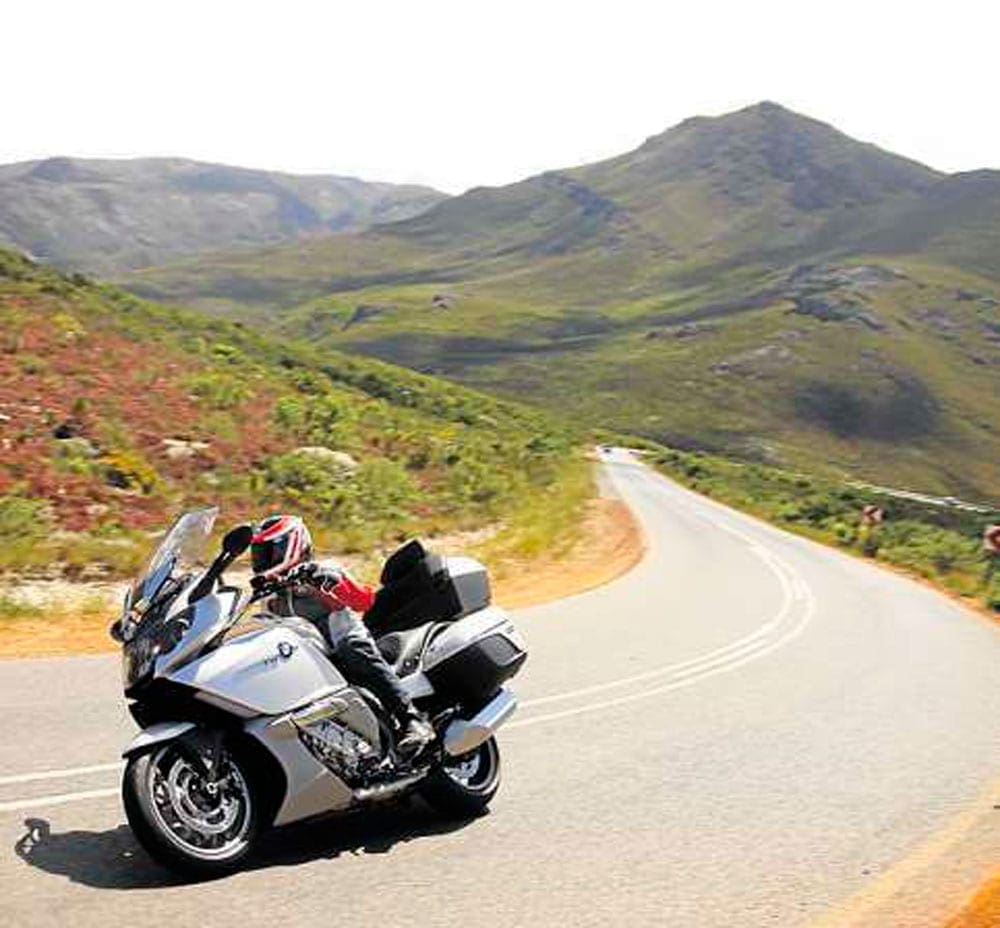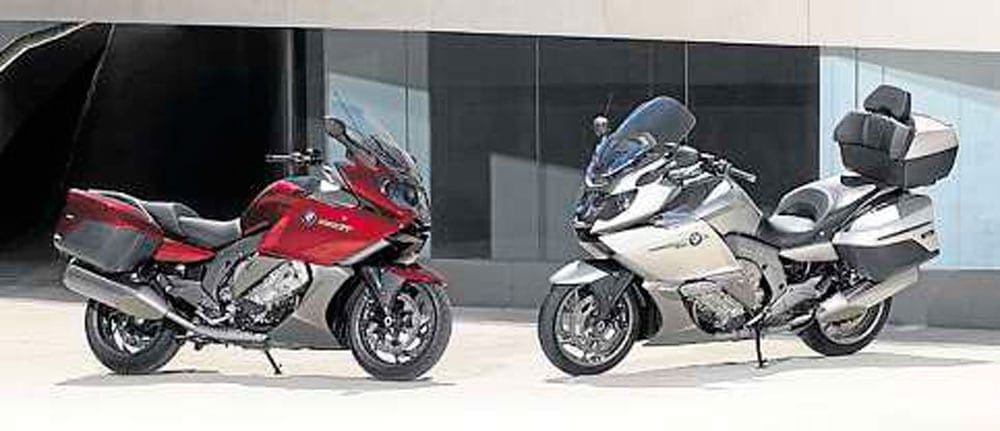While there’s nothing new about inline sixes, BMW’s latest offering of the configuration in their K1600GT supersports tourer has taken the design to all-new heights. Lighter, smaller and more powerful than any production six-cylinder motorcycle engine seen before, the 1649cc, 160bhp motor holds the key to the smoothest of power deliveries and, inturn, one of the most pleasurable riding experiences to grace the biking world so far…
To look at, the K1600GT is every bit your typical big sports tourer. Get the checklist out and sure enough it’s got the big screen, the comfy seat and huge panniers to lug around your holiday essentials on trips down to the south of France. But tourer basics aside, it’s got so much more to offer than any other bike in its field. And that’s mostly down to the engine, with its unprecedented levels of smoothness, abundance of torque and staggeringly powerful acceleration, especially around the 4000-7000rpm mark. The GT also has plenty of bark: the two 3-1 exhaust layout provides a glorious burst of six-cylinder aggression that sounds great as you blip the throttle.
 Back to the engine, and the GT lump has achieved its extremely compact and narrow construction through using a slightly undersquare 67.5 x 72mm stroke/bore ratio and cylinders effectively spaced just 5mm apart, weighing in at 102.6kg overall.
Back to the engine, and the GT lump has achieved its extremely compact and narrow construction through using a slightly undersquare 67.5 x 72mm stroke/bore ratio and cylinders effectively spaced just 5mm apart, weighing in at 102.6kg overall.
Four years in development, this transversely mounted motor’s a masterpiece which easily misleads you into thinking you’re riding something far sportier than a 319kg tourer as you twist the fly-by-wire throttle and power past anything that stands in your way, with no delays or glitches from the fuel injection system.
As you’d expect, the engine’s emphasis is more on torque than flat-out power – even from as low down as 2000rpm, it pulls, all the way up to its 8500rpm rev limiter, meaning you can afford to be lazy with the gears and rely on the bike to do the hard work for you. And on the odd occasion where you have to result to knocking the bike down a gear or two, the lightweight hydraulic clutch and slick constant-mesh gearbox makes life pain-free and easy.
 Just like the engine map selection, which can be adjusted on the move between Rain, Road and Dynamic by the I-drive system on the right handlebar, controlling the bike between different levels of power delivery, plus there’s also Dynamic Traction Control (DTC) to sort out any excessive wheelspin (this is standard on the GT SE version). But, as I discovered on the GT’s launch near Cape Town in South Africa, this bike’s got so much more to it than a mindblowing engine – it’s undoubtedly one of the most technically advanced production bikes ever. There’s an option for just about everything on the 5.7-inch TFT-spec (Thin Film Technology) digital display, which sits right in the middle of the bike’s front fairing console.
Just like the engine map selection, which can be adjusted on the move between Rain, Road and Dynamic by the I-drive system on the right handlebar, controlling the bike between different levels of power delivery, plus there’s also Dynamic Traction Control (DTC) to sort out any excessive wheelspin (this is standard on the GT SE version). But, as I discovered on the GT’s launch near Cape Town in South Africa, this bike’s got so much more to it than a mindblowing engine – it’s undoubtedly one of the most technically advanced production bikes ever. There’s an option for just about everything on the 5.7-inch TFT-spec (Thin Film Technology) digital display, which sits right in the middle of the bike’s front fairing console.
 Using the same technology as you’d find on mobile phones, the hi-tech dash allows you to navigate your way through tons of preferences, including audio options, heated seat temperature settings and even electronic suspension adjustment via the extremely clever ESA II system which incorporates Comfort, Normal and Sport mode settings (optional extra on the base model). You can scroll through everything easily and the system includes a thumbwheel on the left-hand bar.
Using the same technology as you’d find on mobile phones, the hi-tech dash allows you to navigate your way through tons of preferences, including audio options, heated seat temperature settings and even electronic suspension adjustment via the extremely clever ESA II system which incorporates Comfort, Normal and Sport mode settings (optional extra on the base model). You can scroll through everything easily and the system includes a thumbwheel on the left-hand bar.
And it doesn’t stop there, because you’ve then got the option of fine tuning the suspension even further by telling it whether you’re riding solo, with a pillion or simply with luggage. But the best thing about these options is they really do work. On our first ride of the bikes on the Franschhoek Pass, I was hit instantly by how nimble and stable the big GT was through the corners. And on checking, found the bike was only in ‘Comfort’ mode. A click through to ‘Normal’ saw the bike stiffen up more and rebound a bit quicker on bumps, and on application of ‘Sport’ the bike transformed once again into a machine capable of intense cornering, although predictably ground clearance then became an issue as the pegs easily came into contact with the ground bend after bend.
BMW developed this bike to replace their popular K1300GT and, having spoken to the engineers responsible for designing the new aluminium bridge chassis, it was clear that they had strict instructions to produce a similarly well handling machine, without compromise. And that’s somehow which they’ve managed to do, despite the fact the GT is a heavier and more bulky bike.
Suspension-wise, the GT has a Duolever set-up at the front (as on the K1300), plus the familiar BMW Paralever single-sided swingarm and shaft drive arrangement bringing up the rear. In terms of handling performance, this bike is up there with the best sports tourers and I actually found more confidence in the GT and its front end than I have in many more sports focused machines.
A lot of which is probably to do with the riding position, which helps you to relax into the ride. At 5ft 9in I found the position of the footpegs and handlebars perfect for me, along with the 810mm high seat height (adjustable up to830mmas standard), which allowed me to have both feet on the ground every time I came to a stop. Which is a good job, because when you do stop you really can feel the weight of the bike. It’s not so bad that you’ll need to eat spinach and spend six months training down the gym before being strong enough to support the bike while stationary, but it’s worth noting. Especially if you have to paddle the bike two-up by foot or your navigation’s not that great, meaning you spend a lot of time doing U-turns, as I did.
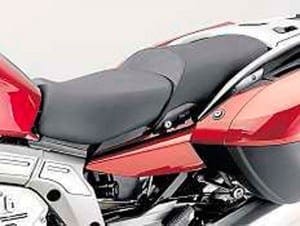 And it was while performing these turns that I found my only real criticism of the bike – there’s no pull on tick-over. This means you’ve got to be super focused while turning at low speeds, ready to slip the clutch, apply the correct amount of throttle and catch the bike’s weight with your feet as it tries to pull you into the ground when you turn the handlebars. And it wasn’t just me with my matchstick-size limbs who struggled on the turns – it was the general consensus of the journalists on the launch. But in the grand scheme of things, it wasn’t a major issue. If you paid attention and followed the inbuilt sat nav, located above the analogue speedo and rev-counter, you wouldn’t need to turn around.
And it was while performing these turns that I found my only real criticism of the bike – there’s no pull on tick-over. This means you’ve got to be super focused while turning at low speeds, ready to slip the clutch, apply the correct amount of throttle and catch the bike’s weight with your feet as it tries to pull you into the ground when you turn the handlebars. And it wasn’t just me with my matchstick-size limbs who struggled on the turns – it was the general consensus of the journalists on the launch. But in the grand scheme of things, it wasn’t a major issue. If you paid attention and followed the inbuilt sat nav, located above the analogue speedo and rev-counter, you wouldn’t need to turn around.
This Garmin device is an added extra to the standard GT, but it’s well worth the investment if you can afford it. And, unlike on other bikes, it’s constantly secure because the minute you stop the engine, the electronically adjustable windscreen powers itself down to make it impossible to remove the device once you’re parked up, before returning to its previous position as soon as you turn the ignition back on again.
The screen’s adjusted on the move by a button on the left handlebar and, dependant on the speed and type of riding you’re doing, you can alter it to throw more air at you or completely shield you from wind, rain and suicidal insects. And even with the screen fully up, you can direct extra airflow on to your body by pulling out some adjustable side scoops (dubbed ‘rabbit’s ears’), which sit between the side and cockpit fairings, great in hot weather.
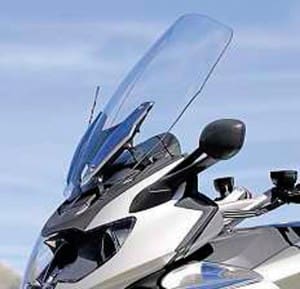 Another neat touch is the optional central locking option, which is pretty useful: as well as the two panniers there are also two additional lockable compartments nestling in the lower fairing. One of the few things which isn’t adjustable on the GT are the brakes but they’re massively effective as standard. Both front and rear systems feature ABS and slow you down ridiculously quickly with no drama, while the proven suspension system provides excellent stability throughout, with minimal front end dive. This gives you the reassurance needed on roads you don’t know, which in turn makes you want to ride more roads and clock up plenty of miles. Which is exactly what a sports tourer should do, isn’t it?
Another neat touch is the optional central locking option, which is pretty useful: as well as the two panniers there are also two additional lockable compartments nestling in the lower fairing. One of the few things which isn’t adjustable on the GT are the brakes but they’re massively effective as standard. Both front and rear systems feature ABS and slow you down ridiculously quickly with no drama, while the proven suspension system provides excellent stability throughout, with minimal front end dive. This gives you the reassurance needed on roads you don’t know, which in turn makes you want to ride more roads and clock up plenty of miles. Which is exactly what a sports tourer should do, isn’t it?
On the fuel side of things, BMW are claiming over 52mpg at a steady constant 56mph for the GT, and around 49mpg at 75mph cruising speeds from the 24-litre tank, which translates into around a range of just over 250 miles to empty, which seems a reasonable estimate at steady, long-distance speeds (we’ll put this to the test properly on a long road trip later in the year).
If I were a betting man I’d put a stack of money down on this bike’s success, especially considering the cheaper than- expected entry level RRP of £14,965 and level of equipment available as standard. BMW have designed the K1600 to be the ‘ultimate European style performance touring bike’ and despite what cynics might think, it’s not just a quirky marketing exercise. Just ride one…
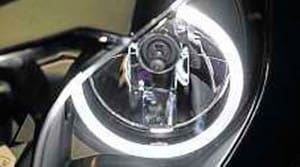 How does the BMW Adaptive Headlight System work?
How does the BMW Adaptive Headlight System work?
BMW’s head of electronic development, Karl-Heinz Gaubatz, is the man behind the clever Adaptive Headlight system fitted to the new K1600GT SE and K1600GTL SE, which keeps the headlight beam where you want it to be. To keep things simple, the system essentially uses a motorised tilting reflector mirror capable of pointing the headlight beam in different directions, all managed by an onboard computer. The system adjusts headlight pitch (so oncoming traffic isn’t dazzled), by using ride height sensors in the front and rear wheel axles to detect when the bike is pitching or diving under braking or acceleration. It then relays that data to the computer, which then adjusts the reflector accordingly.
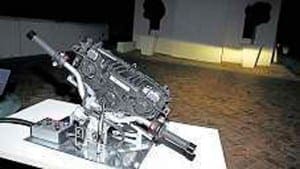 In addition, the headlight also adjusts in relation to the bike’s lean angle around corners. The bike is fitted with an onboard gyro, which tells the computer the correct lean angle, which then adjusts the reflector to aim the beam the way you’re leaning. This obviously makes nighttime riding much safer as the correct area of the road is illuminated.
In addition, the headlight also adjusts in relation to the bike’s lean angle around corners. The bike is fitted with an onboard gyro, which tells the computer the correct lean angle, which then adjusts the reflector to aim the beam the way you’re leaning. This obviously makes nighttime riding much safer as the correct area of the road is illuminated.
Another very useful feature is being able to adjust the beam to riding on the right abroad – no more taping up your lights. Operated via the dash, you can change the reflector so dipped beam doesn’t light up the left and annoy foreign traffic. However, it’s worth noting that you lose the clever lean angle function if you select this feature.
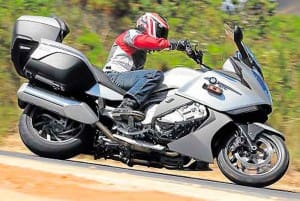 So how does the K1600GTL compare to its sibling GT?
So how does the K1600GTL compare to its sibling GT?
It doesn’t, but then again it’s not really meant to. While it shares the same engine, chassis and hi-tech gadgetry as the GT, it’s a totally different machine to ride. The GTL’s all about luxurious cruising. It’s BMW’s Goldwing, if you like, built for wide open roads and long hot days in the saddle which, incidentally, sits as standard 60mm lower than the GT’s (750mm).
In fact, the ergonomics of the bike are totally different with its longer reaching, lower handlebars, lower mounted rider and pillion footpegs and a massive topbox that comes as standard and can easily consume two full-face helmets.
A wider screen’s also part of the package, along with a bigger fuel tank (26.5 litres compared to the GT’s 24 litre tank) and the weight’s up by 29kg to 348kg. Chrome exhaust cans replace the GT’s stainless items and to fit in with the bike’s chilled out feel, BMW have mellowed the sound they emit. Through the twisties, the GTL’s softer suspension settings still make the bike feel suitably agile for a machine of this size although it doesn’t quite match up to the GT, and mid-corner bumps did seem to upset the bike’s handling a bit more. At high speeds, the GTL is definitely less stable than its sportier brother but only after you’ve breached triple figures. Despite the extra weight, the engine’s still punchy and will easily pull up to its 8500rpm redline, making for no-fuss overtakes. Overall, what the GTL lacks in handling performance, it makes up in comfort.
Tech Spec
Price: K1600GT £14,965 (K1600GT SE £15,765) [K1600GTL £16,515] (K1600 GTLE £17,315)
Engine: 1649cc, liquid-cooled,DOHC 24-valve, six-speed inline six cylinder
Max power (claimed): 160bhp@7750rpm
Max torque (claimed): 129lb-ft@5250rpm
Bore x Stroke: 67.5 x 72mm
Rake and Trail: 62.2º x 106.4mm
Chassis: Aluminium bridge
Suspension: Front:BMW Motorrad Dual longitudinal control arm with 115mm spring travel.
ESA adjustable. Rear:BMW Motorrad Paralever (single-sided swingarm) central spring strut, rebound/continuously variable.135mm spring travel. ESA adjustable.
Brakes: Front:Twin 320mm discs with radially mounted four-piston fixed calipers. Rear:320mm single disc two-piston fixed caliper. ABS as standard.
Wheels/Tyres: Cast aluminium. Front: 120/70/17, Rear: 190/55/17
Wheelbase: 1618mm
Seat height: 810-830mm (standard) [750mm (standard)]
Kerb weight: 319kg (without panniers) [348kg (including panniers and topcase)]
Fuel capacity: 24 litres [26.5 litres]
Colours: Light grey metallic or vermilion red metallic [mineral silver metallic or royal blue metallic]

